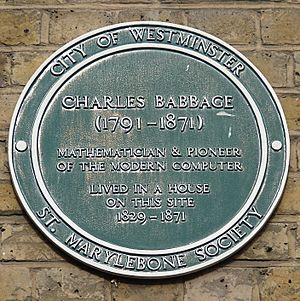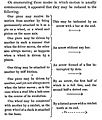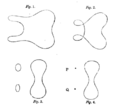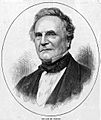Charles Babbage facts for kids
Quick facts for kids
Charles Babbage
KH FRS
|
|
|---|---|
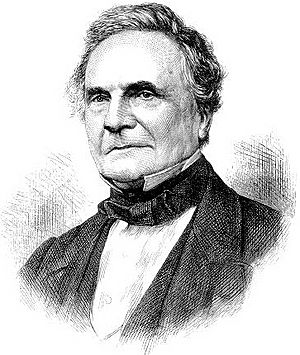
Charles Babbage
|
|
| Born | 26 December 1791 London (likely Southwark)
|
| Died | 18 October 1871 (aged 79) Marylebone, London, UK
|
| Nationality | English |
| Citizenship | British |
| Alma mater | Peterhouse, Cambridge |
| Known for | Difference engine |
| Signature | |
Sir Charles Babbage (26 December 1791 – 18 October 1871) was an English mathematician, analytical philosopher, mechanical engineer and computer scientist. He was the first person to invent the idea of a computer that could be programmed. Unfinished parts of his mechanisms are on display in the London Science Museum.
Contents
Early life and education
Babbage was most likely born in London, England on 26 December 1791. Babbage was one of four children of Benjamin Babbage and Betsy Plumleigh Teape. His father was a banking partner of William Praed in founding Praed's & Co. of Fleet Street, London, in 1801. In 1808, the Babbage family moved into the old Rowdens house in East Teignmouth. Around the age of eight, Babbage was sent to a country school in Alphington near Exeter to recover from a life-threatening fever. For a short time, he attended King Edward VI Grammar School in Totnes, South Devon, but his health forced him back to private tutors for a time.
Babbage then joined the 30-student Holmwood Academy, in Baker Street, Enfield, Middlesex, under the Reverend Stephen Freeman. The academy had a library that prompted Babbage's love of mathematics. He studied with two more private tutors. One of them was an Oxford tutor, under whom Babbage reached a level in Classics sufficient to be accepted by the University of Cambridge.
Babbage arrived at Trinity College, Cambridge, in October 1810. He was already self-taught in some parts of contemporary mathematics; he had read Robert Woodhouse, Joseph Louis Lagrange, and Marie Agnesi. As a result, he was disappointed in the standard mathematical instruction available at the university.
Babbage, John Herschel, George Peacock, and several other friends formed the Analytical Society in 1812.
In 1812, Babbage transferred to Peterhouse, Cambridge. He was the top mathematician there, but did not graduate with honours.
Career
Considering his reputation, Babbage quickly made progress. He lectured to the Royal Institution on astronomy in 1815, and was elected a Fellow of the Royal Society in 1816.
After graduation, Babbage depended awkwardly on his father's support for some time. In 1814, he and Edward Ryan wedded the Whitmore sisters. He made a home in Marylebone in London and established a large family. On his father's death in 1827, Babbage inherited a large estate (value around £100,000, equivalent to £7.29 million or $9.99 million today), making him independently wealthy. After his wife's death in the same year he spent time travelling.
Babbage was instrumental in founding the Royal Astronomical Society in 1820, initially known as the Astronomical Society of London. Its original aims were to reduce astronomical calculations to a more standard form, and to circulate data. These directions were closely connected with Babbage's ideas on computation, and in 1824 he won its Gold Medal, cited "for his invention of an engine for calculating mathematical and astronomical tables".
Babbage worked and wrote on many ideas of science, engineering and mathematics, but he is most famous for two machines he started and never finished. His Difference Engine would have been a much better calculator than any made before then. His Analytical Engine would have been the first real computer.
Knowing that there were many errors in the calculation of mathematical tables, Babbage wanted to find a way to calculate them mechanically, removing errors made by humans. Three different factors seem to have influenced him: a dislike of untidiness; his experience working on logarithmic tables and differential calculus; and work on calculating machines already done by Wilhelm Schickard, Blaise Pascal, and Gottfried Leibniz. He first talked about the principles of a calculating engine in a letter to Sir Humphrey Davy in 1822.
Babbage's engines were among the first mechanical computers. His engines were not actually completed because he did not have enough money. Babbage realized that a machine could do the work better and more reliably than a human being. Babbage controlled building of some steam-powered machines that more or less did their job; calculations could be mechanized to an extent. Although Babbage's machines were large machines they were organized in a way similar to modern computer architecture. The data and program memory were separated, operation was instruction based, control unit could make conditional jumps and the machine had a separate I/O unit. Ada Lovelace studied how to program them.
Babbage published On the Economy of Machinery and Manufactures (1832), on the organisation of industrial production. It was an influential early work of operational research. In the book, Babbage described what is now called the "Babbage principle": a more careful division of labour leads to commercial advantages. What Babbage meant was that skilled workers typically spend parts of their time performing tasks that are below their skill level. If the labour process can be divided among several workers, labour costs may be cut by assigning only high-skill tasks to high-cost workers, restricting other tasks to lower-paid workers.
In 1838, Babbage invented the pilot (also called a cow-catcher), the metal frame attached to the front of locomotives that clears the tracks of obstacles; he also constructed a dynamometer car.
Babbage also invented an ophthalmoscope, which he gave to Thomas Wharton Jones for testing. Jones, however, ignored it. The device only came into use after being independently invented by Hermann von Helmholtz.
Babbage achieved notable results in cryptography, though this was still not known a century after his death.
Family
On 25 July 1814, Babbage married Georgiana Whitmore at St. Michael's Church in Teignmouth, Devon; her sister Louisa married Sir Edward Ryan five months later. The couple lived at Dudmaston Hall, Shropshire (where Babbage engineered the central heating system), before moving to 5 Devonshire Street, London in 1815.
Charles and Georgiana had eight children, but only four – Benjamin Herschel, Georgiana Whitmore, Dugald Bromhead and Henry Prevost – survived childhood. Charles' wife Georgiana died in Worcester on 1 September 1827, the same year as his father, their second son (also named Charles) and their newborn son Alexander.
- Benjamin Herschel Babbage (1815–1878)
- Charles Whitmore Babbage (1817–1827)
- Georgiana Whitmore Babbage (1818–????)
- Edward Stewart Babbage (1819–1821)
- Francis Moore Babbage (1821–????)
- Dugald Bromhead (Bromheald?) Babbage (1823–1901)
- (Maj-Gen) Henry Prevost Babbage (1824–1918)
- Alexander Forbes Babbage (1827–1827)
His youngest surviving son, Henry Prevost Babbage (1824–1918), went on to create six small demonstration pieces for Difference Engine No. 1 based on his father's designs, one of which was sent to Harvard University where it was later discovered by Howard H. Aiken, pioneer of the Harvard Mark I. Henry Prevost's 1910 Analytical Engine Mill, previously on display at Dudmaston Hall, is now on display at the Science Museum.
Death
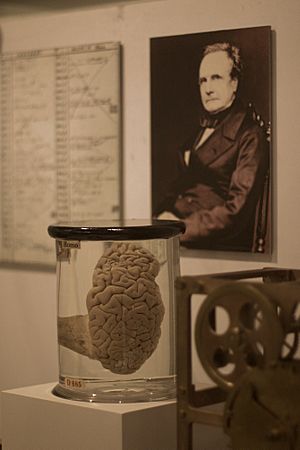
Babbage lived and worked for over 40 years at 1 Dorset Street, Marylebone, where he died, at the age of 79, on 18 October 1871; he was buried in London's Kensal Green Cemetery. He had declined both a knighthood and baronetcy. He also argued against hereditary peerages, favouring life peerages instead.
Autopsy report
In 1983, the autopsy report for Charles Babbage was discovered and later published by his great-great-grandson. A copy of the original is also available. Half of Babbage's brain is preserved at the Hunterian Museum in the Royal College of Surgeons in London. The other half of Babbage's brain is on display in the Science Museum, London.
Memorials
There is a black plaque commemorating the 40 years Babbage spent at 1 Dorset Street, London. Locations, institutions and other things named after Babbage include:
- The Moon crater Babbage
- The Charles Babbage Institute, an information technology archive and research center at the University of Minnesota
- The Charles Babbage Premium, an annual computing award
- British Rail named a locomotive after him in the 1990s
- The Babbage Building at the University of Plymouth, where the university's school of computing is based
- The Babbage programming language for GEC 4000 series minicomputers
- "Babbage", The Economist's Science and Technology blog.
- The former chain retail computer and video-games store "Babbage's" (now GameStop) was named after him.
Related pages
Images for kids
-
Part of Charles Babbage's Difference Engine (#1), assembled after his death by his son, Henry Prevost Babbage (1824–1918), using parts found in Charles' laboratory. Whipple Museum of the History of Science, Cambridge, England.
-
Part of the Analytical Engine on display, in 1843, left of centre in this engraving of the King George III Museum in King's College, London.
See also
 In Spanish: Charles Babbage para niños
In Spanish: Charles Babbage para niños




